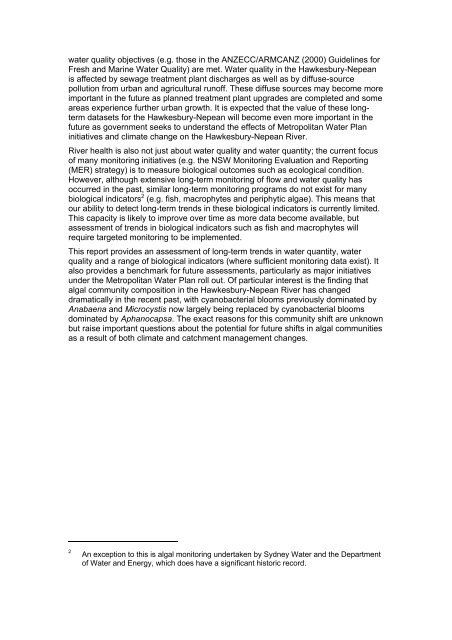Hawkesbury-Nepean River Environmental Monitoring Program
Hawkesbury-Nepean River Environmental Monitoring Program
Hawkesbury-Nepean River Environmental Monitoring Program
Create successful ePaper yourself
Turn your PDF publications into a flip-book with our unique Google optimized e-Paper software.
water quality objectives (e.g. those in the ANZECC/ARMCANZ (2000) Guidelines for<br />
Fresh and Marine Water Quality) are met. Water quality in the <strong>Hawkesbury</strong>-<strong>Nepean</strong><br />
is affected by sewage treatment plant discharges as well as by diffuse-source<br />
pollution from urban and agricultural runoff. These diffuse sources may become more<br />
important in the future as planned treatment plant upgrades are completed and some<br />
areas experience further urban growth. It is expected that the value of these longterm<br />
datasets for the <strong>Hawkesbury</strong>-<strong>Nepean</strong> will become even more important in the<br />
future as government seeks to understand the effects of Metropolitan Water Plan<br />
initiatives and climate change on the <strong>Hawkesbury</strong>-<strong>Nepean</strong> <strong>River</strong>.<br />
<strong>River</strong> health is also not just about water quality and water quantity; the current focus<br />
of many monitoring initiatives (e.g. the NSW <strong>Monitoring</strong> Evaluation and Reporting<br />
(MER) strategy) is to measure biological outcomes such as ecological condition.<br />
However, although extensive long-term monitoring of flow and water quality has<br />
occurred in the past, similar long-term monitoring programs do not exist for many<br />
biological indicators 2 (e.g. fish, macrophytes and periphytic algae). This means that<br />
our ability to detect long-term trends in these biological indicators is currently limited.<br />
This capacity is likely to improve over time as more data become available, but<br />
assessment of trends in biological indicators such as fish and macrophytes will<br />
require targeted monitoring to be implemented.<br />
This report provides an assessment of long-term trends in water quantity, water<br />
quality and a range of biological indicators (where sufficient monitoring data exist). It<br />
also provides a benchmark for future assessments, particularly as major initiatives<br />
under the Metropolitan Water Plan roll out. Of particular interest is the finding that<br />
algal community composition in the <strong>Hawkesbury</strong>-<strong>Nepean</strong> <strong>River</strong> has changed<br />
dramatically in the recent past, with cyanobacterial blooms previously dominated by<br />
Anabaena and Microcystis now largely being replaced by cyanobacterial blooms<br />
dominated by Aphanocapsa. The exact reasons for this community shift are unknown<br />
but raise important questions about the potential for future shifts in algal communities<br />
as a result of both climate and catchment management changes.<br />
2 An exception to this is algal monitoring undertaken by Sydney Water and the Department<br />
of Water and Energy, which does have a significant historic record.
















